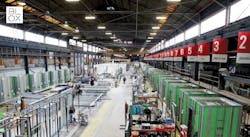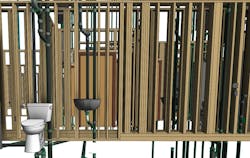The epic rise of industrialized construction
The construction industry is facing colliding forces that render our current trajectory wasteful, inefficient, and unsustainable. These include a widespread skilled labor shortage and industry productivity rates that continually fail to improve. This is the burning platform that this relatively undisrupted $8+ trillion global industry rests upon. Multiple things need to change, but there are clearly obvious wins to go after.
Enter prefabrication and modular construction. Predicted to grow at 6.50% CAGR between 2015 and 2020, experts project that prefabrication and modular construction will total USD $209 billion by the end of the decade.
The reasons for this meteoric rise are simple: these approaches address some of the most complex issues of modern building, including long timelines, scaling difficulties, and volatility created by variable projects. These methods also use less construction materials than traditional approaches and are flexible enough to accommodate the unique building challenges of today.
And most importantly, industrialized construction addresses both the declining productivity curve and the skilled labor shortage (80% of contractors report struggling to find qualified workers).
Both intelligent and forward-looking methods, prefabrication and modular construction support the needs of residential, industrial, and commercial building around the world and stand to change the construction industry for the better.
Because of this, Venture Capital funding, along with experts from aerospace, semiconductor, and automotive manufacturing industries, are flocking into construction. Unfortunately, securing this attention is only part of the battle.
Copying the processes of the manufacturing industry and attempting to shift them into the construction industry will only get us slightly closer to the dream of prefab. Instead, enabling prefabrication in construction will require a complete paradigm shift and a solution that is unique to construction - not one that’s simply been borrowed from manufacturing.
Setting the Stage for Prefabrication and Modular Construction
Rendering: VIATechnik
While digitized construction is a fantastic solution to many common pain points, the industry must undergo some significant shifts to make way for it. Since each construction project is different, industrialized construction must adopt a fluid and flexible approach to support the new wave of building.
Although modular construction and prefabrication methods will allow companies to adapt to varied building projects, the first step is for the industry to adopt approaches like virtual prototypes, building information modeling (BIM), data collection, data sanitization, and digitization throughout the supply chain.
These steps (virtual prototyping specifically) ensure a comprehensive and well thought-out building process that is capable of more rapid iteration and adaptation. When the mindset of the traditional construction worker begins to change, the entire industry wins.
The Problem With Modern Fabrication Tools
The tools that the construction industry currently use are not designed with fabrication in mind. This leads to short-sighted decisions and building projects riddled with easily preventable problems, which is not the case in other industries.
Rendering: VIATechnik, Dassault's CATIA xGenerative Design
In the automotive and ship-building industries, for example, tools (such as Dassault’s Catia software) are built to enable design and fabrication. This allows for smoother and more comprehensive modeling and a more streamlined building process. In yet other industries, iteration happens on a real-time basis. Semiconductor engineers iterate on the factory line, for example - throwing away thousands of chips until they come up with the perfect design.
While this model is not applicable to the construction industry (we can’t throw away the first thousand walls, after all), GCs and owner-builders must master the process of iterating virtually, which ensures construction-ready products straight off the line. This requires a shift toward digitization and more enthusiastic adoption of modular and prefabricated building methods.
Fragmentation and the Supply Chain
There is yet another hurdle standing in the way of digitized industrial construction, and that is the supply chain. As it stands now, the supply chain is fragmented, which is creating unnecessary gaps in the industry. To support intelligent building models like prefabrication and modular construction, the entire supply chain must shift and go digital.
WeWork and Katerra are two companies that are trying to become vertically integrated through acquisitions, but they also have a tremendous amount of funding. Softbank’s vision fund invested 4.4B in WeWork and led an 865M round in Katerra. WeWork raised 8.1B in 12 rounds and Katerra has raised 1.1B. So, if you don’t have $1B in funding, vertically integrating the supply chain may not be in the cards.
Many players in the manufacturing industry attempt to solve this supply chain issue through partnerships. Apple, for example, doesn’t own the glass manufacturer for the iPhone. They do, however, have a long-term contract that ensures a supply process optimized for Apple.
In the construction industry, this process looks a bit different. Today, the majority of trade contractors and suppliers operate on a project-by-project basis. This is a fragmented approach, though, and its stifling innovation. When GCs aren’t sure whether they’re going to secure that next project, it becomes impossible to adjust the supply chain process for maximum efficiency and optimization.
The Future of Building Begins Here
Today, professionals considering prefabrication must understand that the solution that will work in construction is uniquely ours. How we adjust the supply chain, embrace digital transformation, and make room for new building models will define how (and how quickly) the industry moves forward toward bigger rewards and increased efficiency.


